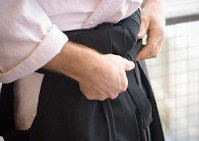The historical ninja schools specialised in espionage and assassinations and often were reputed to be the secret side to some lineages. Their training also included various weapons and hand to hand combat techniques.
Many of the techniques of Aikido and Ninjitsu have a remarkable similarity owing to this shared history but today have different focuses. A key difference though is that Aikido techniques finish by controlling or subduing the opponent rather than disabling them in a traditional combative sense. The arts are sufficiently similar that Aikido might offer what you are looking for in Ninjitsu so please peruse the site and see what you think. Consider swapping your black pajamas for white ones and a skirt 😉 (See Aikido Classes)
History of Ninjitsu
There are many other schools of jutsu today. Some have very strong lineages to Japan and some don’t. Ninjitsu schools are no exception, though it is a widely held view that the formal lineage of Ninjitsu has at times been broken, thus today there are two main schools that claim legitimacy through various means. For more reading Wikipedia has a balanced treatment and Koryu Books issued a statement on the koryu nature of Ninjitsu.
Today there are a number of well known Ninjitsu lineages, some are more exclusive than others. Many times the locations of ninja dojo aren’t public and you must make contact first to find them – all part of the art I guess. In the past some have taken advantage of the historical secrecy of this art and are representing themselves as Ninjitsu practicioners. Ninjitsu schools also practice stealth and using unusual weapons in addition to throws, pins and weapon training that most jujitsu lineages (and indeed aikido) schools undertake. Wayne Roy is largely credited with bringing Ninjitsu to Australia and to Brisbane in particular, though he is thought to be independent these days.

